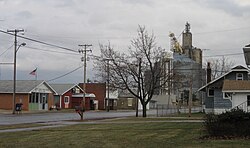Hume, Illinois
| Hume | |
|---|---|
| Village | |

Front Street of Hume, 2008
|
|
 Edgar County's location in Illinois |
|
| Hume's location in Edgar County | |
| Coordinates: 39°47′48″N 87°52′07″W / 39.79667°N 87.86861°WCoordinates: 39°47′48″N 87°52′07″W / 39.79667°N 87.86861°W | |
| Country |
|
| State |
|
| County | Edgar |
| Township | Shiloh, Young America |
| Incorporated | 1873 |
| Area | |
| • Total | 0.54 sq mi (1.4 km2) |
| • Land | 0.54 sq mi (1.4 km2) |
| • Water | 0.00 sq mi (0.0 km2) |
| Elevation | 663 ft (202 m) |
| Population (2010) | |
| • Total | 380 |
| • Density | 743.2/sq mi (287/km2) |
| ZIP code | 61932 |
| Area code(s) | 217 |
| GNIS feature ID | 0410680 |
Hume is a village in Shiloh and Young America townships, Edgar County, Illinois, United States. As of the 2010 census, the village population was 380.
The future site of Hume was most likely part of the Illinois Confederation in the Pre-Columbian period. White settlers of the 19th century in the area reported relationships with Kickapoo peoples.
In the early 19th century, the area of Illinois including the future site of the Village of Hume and the Young America Township was prairie and thus considered unsuitable for settlement or tillage. Land speculators bought local land from the government (known as "entering land") on the hope that it would become possible to cultivate it in the near future. Large herds of cattle often grazed on the open land during this period.
In 1857, the Indiana and Illinois Airline railroad was laid out and graded, although it would be fifteen years before rails were laid. In February 1865, Elzephan W. S. Hume moved to Illinois from Boone County, Kentucky, and purchased about 300 acres (1.2 km2) of land along the proposed line of the Indiana and Illinois Airline railroad. By November, he opened a farm and began cultivation. In the spring of 1873, the railroad was complete through Edgar county. In later years, the railroad was expanded to Indianapolis and was called the Indianapolis, Decatur and Springfield Railway. The railroad would change names several times before being incorporated into the Baltimore and Ohio Railroad.
In 1873, E. W. S. Hume made plans for a town on his land, although no buildings existed on the planned town at that time. He also made an agreement with the railroad company to build a station for Hume, in exchange for lots of land in the new village. The names Elzephan W. S. Hume, Henry C. Moore, Thomas H. McCoughty, and H. B. Hammond appear on the original plat for the incorporation of Hume. George W. Foreman laid out the village of Hume in early November 1873 for those four men.
...
Wikipedia

